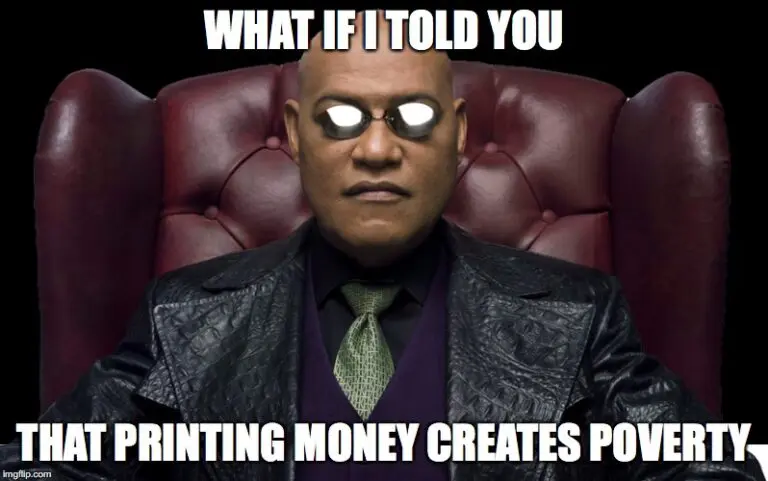
If you wanted to become the most powerful person in the world, how would you do it?
Work harder than everyone else? Suck up to other powerful people and get promoted? Create the largest army? Pray for a genie to come out of a magic lamp? Develop a nuclear weapon that could wipe out the earth, and hold the world hostage?
The answer to this question is actually an easy one, because it has been played out in real-life: give yourself an unlimited supply of cash. With unlimited money, you can do almost anything and nobody else stands a chance. How can this be done? Again, easy: build a giant money-printer, and then bribe enough Congresspeople to pass a law that makes it illegal for anyone else to print the same currency in the same region. Voilà!
This is what happened in 1913 with the creation of the Federal Reserve Bank. Since then, a single, privately-owned bank has the exclusive right (in the U.S.) to print fake money and charge everyone else for using it. If you try and challenge that territorial right, you’ll be up against the largest military apparatus in the world. Not even the President of the United States can challenge the central bank’s power. Those who do—like JFK—aren’t exactly treated with kindness. Even Trump talked hard against the Fed before his election, but after his election hasn’t said a negative word about the central bank, much less challenged any of its monetary policies. In any case, Congresspeople have an incentive to maintain this system because they can borrow as much as they want from the central bank (which is essential for re-election). The incentive for the central bank’s owners, on the other hand, is obvious (unlimited money, dood!).
Virtually all governments operate according to this model. Each nation-state has their own central bank by which it can achieve economic dominance and power. Presidents, dictators, and rulers pay their armies with the currency of the central bank—and usually require all citizens to use the same currency, whether privately or publicly (i.e., taxation).
But, there’s a really big catch to this whole system…
There’s no free lunch. Printing money is not the same as creating wealth—though it seems that way at first. Printing currency doesn’t create a factory for building cars, roasters for coffee houses, or microchips for computers. Actual wealth production only comes from…well, production. Transforming land, labor, and capital into something useful. Entrepreneurship. Innovation. Calculation and planning. All of that. The mere printing of currency doesn’t do any of this. In fact, it devalues the currency’s purchasing power, so now everything gets more expensive instead of less expensive. Why has the same can of soda-pop increased in price over the past century instead of decreased? Answer: inflation.
In economic terms, monetary inflation (increasing the money supply) leads to ‘inflation’ (an increase in the prices of goods). Printing money has a huge cost. This means that the central banksters actually fund themselves off the backs of everyone else—who have to pay more, and more, and more for the same gallon of milk year after year. Worse, people’s savings are eroded away like a sandy path during a rainstorm. $50,000 USD used to be able to buy a house; now it can barely buy a car. Year after year, savings are erased and good living conditions become less obtainable.
But it gets worse. Inflation occurs in waves over time, not instantly everywhere, and therefore it (a) privileges the first-users and (b) distorts prices in the economy. If someone drops red ink at one place in a pool, it appears as a strong red in a small area, but a little while later it expands and becomes more and more pink, until finally the ink is hardly visible at all in the whole pool. It’s the same with inflation. The purchasing power of newly printed money is strong at the beginning (in commercial banking), but diminishes as it gets slushed around the economy. By the time it reaches school teachers and janitors, the full devaluation of the currency has been achieved, and everyone complains about “how everything is so much more expensive than it used to be.”
Eventually, a fiat currency that is printed too fast for too long will inflate to nothing, and true poverty is finally achieved. This has happened dozens of times in the last century, and is happening right now in Venezuela.
All of this points to the same paradoxical (but accurate) conclusion: printing money doesn’t create wealth; printing money creates poverty.
Articles posted on LCI represent a broad range of views from authors who identify as both Christian and libertarian. Of course, not everyone will agree with every article, and not every article represents an official position from LCI. Please direct any inquiries regarding the specifics of the article to the author.
Did you read this in a non-English version? We would be grateful for your feedback on our auto-translation software.
), //libertarianchristians.com/wp-content/plugins/smartquizbuilder/includes/images/template6-latest.jpeg))

), https://libertarianchristians.com/wp-content/plugins/smartquizbuilder/includes/images/template6-latest.jpeg))








































), https://libertarianchristians.com/wp-content/plugins/smartquizbuilder/includes/images/template6-latest.jpeg))
), https://libertarianchristians.com/wp-content/plugins/smartquizbuilder/includes/images/template6-latest.jpeg))
), https://libertarianchristians.com/wp-content/plugins/smartquizbuilder/includes/images/template6-latest.jpeg))





*by signing up, you also agree to get weekly updates to our newsletter
Sign up and receive updates any day we publish a new article or podcast episode!